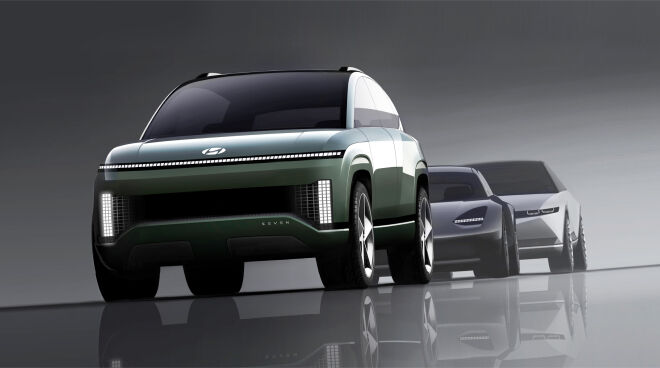Hyundai, the South Korean automotive giant, has carved a unique niche in the global market not only through technological innovation but also through its distinctive design philosophy. This article delves deep into Hyundai’s approach to design, exploring its evolution, key principles, and the impact of its design philosophy on the automotive industry.
The Evolution of Hyundai’s Design Philosophy
Hyundai’s journey in automotive design has been marked by significant transformations, reflecting both internal innovation and responses to external market trends.
Foundational Years and Influences
- Hyundai’s early designs were pragmatic, focusing on reliability and affordability.
- Japanese and European influences shaped Hyundai’s initial design aesthetics.
- The appointment of Peter Schreyer as Chief Design Officer in 2006 marked a pivotal moment.
Also Read : Decoding the Hyundai Car Design Language
The Era of Fluidic Sculpture
- From 2010 onwards, Hyundai embraced the “Fluidic Sculpture” design language.
- Characterized by flowing lines and dynamic forms, Fluidic Sculpture aimed to imbue Hyundai vehicles with a sense of motion and elegance.
- Examples include the Hyundai Sonata and Hyundai Santa Fe, which gained acclaim for their striking designs.
Current Design Philosophy: Sensuous Sportiness
- In recent years, Hyundai has transitioned to its “Sensuous Sportiness” design philosophy.
- This approach combines sensuous shapes with sporty characteristics, aiming to evoke passion and dynamism.
- Models such as the Hyundai Tucson and Hyundai Elantra exemplify this evolution with their bold exteriors and sophisticated interiors.
Key Elements of Hyundai’s Design Philosophy
Understanding Hyundai’s design philosophy involves recognizing several core elements that define its vehicles and distinguish them in the market.
1. Cascading Grille
- The cascading grille has become a hallmark feature of Hyundai vehicles.
- It signifies modernity and a commanding presence on the road.
- Hyundai adapts the grille’s design to suit different models, ensuring it complements each vehicle’s overall aesthetic.
2. Parametric Dynamics
- Introduced with the Sensuous Sportiness philosophy, parametric dynamics refer to intricate patterns and textures incorporated into Hyundai’s design language.
- These elements add visual depth and sophistication, enhancing both exterior and interior aesthetics.
- Examples include the geometric patterns on lighting signatures and interior surfaces.
3. Sensuous Sportiness
- Central to Hyundai’s current design ethos is the concept of Sensuous Sportiness.
- This philosophy emphasizes emotional design elements that evoke excitement and pleasure.
- It encompasses dynamic proportions, sculpted surfaces, and a sense of movement in every vehicle.
Impact of Hyundai’s Design Philosophy
Hyundai’s commitment to design excellence extends beyond aesthetics, influencing consumer perception, market positioning, and industry trends.
Global Recognition and Consumer Appeal
- Hyundai’s design language resonates globally, contributing to its appeal across diverse markets.
- The brand’s ability to balance innovation with cultural sensitivity enhances its international standing.
Competitive Advantage and Differentiation
- Distinctive design elements give Hyundai a competitive edge in the automotive market.
- The brand’s unique identity helps it stand out amidst fierce competition from both traditional automakers and new entrants.
Driving Innovation and Future Trends
- Hyundai’s design philosophy drives innovation in automotive design practices.
- The brand continuously explores new technologies and materials to stay ahead of evolving consumer expectations.
Future Directions and Sustainability
Looking forward, Hyundai’s design philosophy is poised to embrace sustainability and advanced technology integration.
Sustainable Design Practices
- Hyundai is integrating sustainable materials and eco-friendly processes into its design and manufacturing.
- This commitment aligns with global efforts towards environmental responsibility and reduces the ecological footprint of Hyundai vehicles.
Technological Advancements
- Advancements in electric vehicles and autonomous driving technologies influence Hyundai’s design strategies.
- These technologies not only enhance vehicle performance but also shape exterior and interior design elements.
Human-Centered Design Innovations
- Hyundai prioritizes human-centered design principles to enhance user experience and comfort.
- Interior layouts, connectivity features, and ergonomic considerations are central to this approach.
Conclusion
In conclusion, Hyundai’s design philosophy is a testament to its evolution as a global automotive leader. From practical beginnings to the expressive forms of Fluidic Sculpture and Sensuous Sportiness, Hyundai continues to redefine automotive design boundaries. By unraveling Hyundai’s design philosophy, consumers gain insight into the brand’s commitment to innovation, aesthetics, and sustainability, setting a benchmark for the industry’s future.
(source)
Originally posted 2024-06-27 03:25:48.
